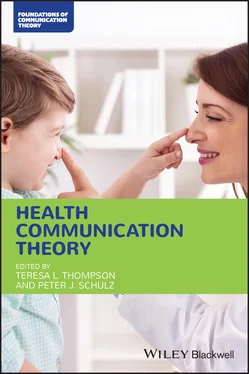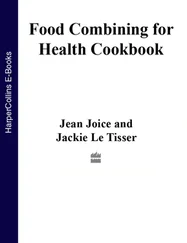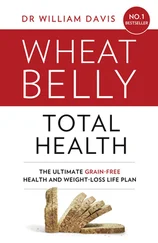Rhetorical studies of health and medicine have increasingly embraced theoretical frameworks and methods that can account for the complexities of language as social action, shifting our focus from texts to the networks, ecologies, and activity systems that shape health‐related discourse and its effects. Many rhetoricians of health and medicine are looking beyond traditional rhetorical theory and methods – with their emphases on the persuasive moves of authors in texts – to explore other means of rhetorical inquiry… that foreground interconnectedness, materiality, and movement in health and medicine.
(Scott, Segal, and Keranën 2013, p. 3)
Indeed, Jensen (2015) positioned the articulation and tracing of health‐related arguments in and through time as a major objective of scholarship in rhetoric of health and medicine, and she offered two different but related orientations for engaging this approach. In the first, research focuses on the interaction of different kinds of rhetoric across a largely chronological timeline to constitute broader health landscapes. As an example, Jensen (2016) drew from doctor–patient correspondence, oral histories, and contemporary popular and scientific news coverage to trace the transformation of language surrounding infertility and the implications of those rhetorical constructions on individuals and the societies in which they live.
In the second approach, research demonstrates how historical arguments about health percolate up at distinct, chronologically disjointed moments: “The exploration of health as it was conceptualized in even the distant past can be understood… as a valuable contribution to delineating conceptualizations of health today that may not follow a linear or rational logic” (Jensen 2015, p. 524). To illustrate, consider the notable study on mothering, media, and medical expertise conducted by historian Bethany Johnson and health communication scholar Maggie Quinlan (2019). They engaged historical texts (e.g. doctors’ notes and family papers) and present‐day social media texts (e.g. comments and hashtags) to discover how such discourses have challenged and continue to challenge and create expertise and power relations in defining the good mother. Other studies have examined the rhetorical work of genres, such as Cole and Carmon’s (2019) analysis of addiction‐related obituaries, and the rhetoric of a particular area or topic, like Miller’s (2019) analysis of fat stigma as rhetorical disability or Alderton’s (2018) analysis of the aesthetics of self‐harm (i.e. visual rhetoric) in online communities.
Zoller and Kline (2008) defined the goal of interpretive, critical, and rhetorical health communication research as seeking “to better understand interpretation and the process of meaning making … [and] to provide in‐depth understanding of lived experience or a unique, well‐argued and defended interpretation of a discourse to impart some insight into the multiple ways in which communication fosters particular meanings” (p. 93). From these paradigms, grounded theory, narrative theorizing, autoethnography, and rhetoric of health and medicine intertwine theory and method to contribute a rich body of interdisciplinary scholarship in health‐related contexts.
Special thanks to Barbara Sharf for the insightful comments that prompted the creation of this chapter and the generous feedback provided as I wrote it.
1 Alderton, Z. (2018). The aesthetics of self‐harm: The visual rhetoric of online self‐harm communities. Abingdon, UK: Routledge.
2 Allen‐Collinson, J. (2013). Autoethnography as the engagement of self/other, self/culture, self/politics, and selves/futures. In S. Holman Jones, T. E. Adams, & C. Ellis (Eds.), Handbook of autoethnography (pp. 281–299). Walnut Creek: CA: Left Coast Press.
3 Anderson, L. (2006). Analytic autoethnography. Journal of Contemporary Ethnography, 35(4), 373–395. doi:10.1177/0891241605280449
4 Baglia, J. (2019). Beginning again: Diagnosis as breach, survival as a new normal. In L. W. Peterson & C. E. Kiesinger (Eds.), Narrating midlife: Crisis, transition, and transformation (pp. 107–130). Lanham, MD: Lexington Books.
5 Birk, L. B. (2013). Erasure of the credible subject: An autoethnographic account of chronic pain. Cultural Studies – Critical Methodologies, 13(5), 390–399. doi:10.1177/1532708613495799
6 Bochner, A. P. (2014). Coming to narrative: A personal history of paradigm change in the human sciences. New York, NY: Routledge.
7 Bochner, A. P., & Ellis, C. (2016a). The ICQI and the rise of autoethnography: Solidarity through community. International Review of Qualitative Research, 9(2), 208–217. doi:10.1525/irqr.2016.9.2.208
8 Bochner, A. P., & Ellis, C. (2016b). Evocative ethnography: Writing lives and telling stories. New York, NY: Routledge.
9 Brown, M. M. (2019). Don’t be the “fifth guy”: Risk, responsibility, and the rhetoric of handwashing campaigns. Journal of Medical Humanities, 40, 211–224. doi:10.1007/s10912‐017‐9470‐4
10 Bruner, J. (1990). Acts of meaning. Cambridge, MA: Harvard University Press.
11 Burke, K. (1984 [1935]). Permanence and change (3rd ed.). Berkeley, CA: University of California Press. (Original work published 1935).
12 Chang, H. (2016). Autoethnography in health research: Growing pains? Qualitative Health Research, 26(4), 443–451. doi:10.1177/1049732315627432
13 Charmaz, K. (2006). Constructing grounded theory: A practical guide through qualitative analysis. London: Sage.
14 Charon, R. (2006). Narrative medicine: Honoring the stories of illness. Oxford: Oxford University Press.
15 Charon, R. (2009). Narrative medicine as witness for the self‐telling body. Journal of Applied Communication Research, 37(2), 118–131. doi:10.1080/00909880902792248
16 Cole, K. L. (2020). The paradox of patient consent: A feminist account of illness and healthcare. Health Communication, 1–10. doi:10.1080/10410236.2020.1724645
17 Cole, K. L., & Carmon, A. F. (2019). Changing the face of the opioid epidemic: A generic rhetorical analysis of addiction obituaries. Rhetoric of Health & Medicine, 2(3), 291–320. doi:10.5744/rhm.2019.1014
18 Corbin, J. (2009). Taking an analytic journey. In J. M. Morse, P. N. Stern, J. Corbin, B. Bowers, K. Charmaz, & A. E. Clarke (Eds.), Developing grounded theory: The second generation (pp. 35–54). Walnut Creek, CA: Left Coast Press.
19 de Souza, R. (2007). The construction of HIV/AIDS in Indian newspapers: A frame analysis. Health Communication, 21(3), 257–266. doi:10.1080/10410230701307733
20 Defenbaugh, N. L. (2013). Revealing and concealing ill identity: A performance narrative of IBD disclosure. Health Communication, 28(2), 159–169. doi:10.1080/10410236.2012.666712
21 Dillon, P. J., & Basu, A. (2016). African Americans and hospice care: A culture‐centered exploration of enrollment disparities. Health Communication, 31(11), 1385–1394. doi:10.1080/10410236.2015.1072886
22 Donovan‐Kicken, E., Tollison, A. C., & Goins, E. S. (2012). The nature of communication work during cancer: Advancing the theory of illness trajectories. Health Communication, 27(7), 641–652. doi:10.1080/10410236.2011.629405
23 Dutta, M. J., & Zoller, H. M. (2008). Theoretical foundations: Interpretive, critical, and cultural approaches to health communication. In H. M. Zoller & M. J. Dutta (Eds.), Emerging perspectives in health communication: Meaning, culture, and power (pp. 1–27). New York, NY: Routledge.
24 Edley, P., & Battaglia, J. (2016). Dying of dismissal: An autoethnographic journey of chronic illness. Women & Language, 39(1), 33–48.
25 Ellingson, L. L. (2005). Communicating in the clinic. Creskill, NJ: Hampton Press.
Читать дальше












